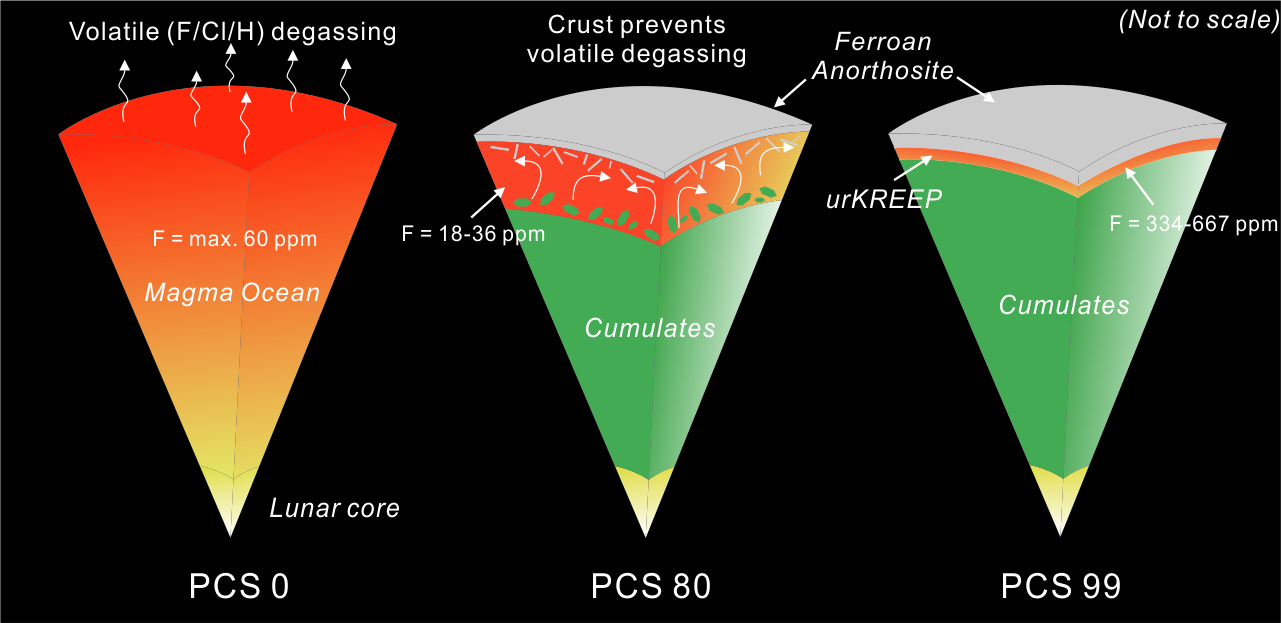Fluorine abundances show effective shutdown of lunar volatile outgassing by crust formation
- 1Faculty of Science, Vrije Universiteit Amsterdam, De Boelelaan 1085, 1081 HV Amsterdam, The Netherlands
- 2Institut für Mineralogie, Westfälische Wilhelms-Universität Münster, Correnstraße 24, D48149 Münster, Germany
The observed strong depletions of volatile compounds, including chlorine and lead, in lunar rocks compared to terrestrial samples have been used to argue for significant early volatile loss from the Moon due to degassing (e.g., Sharp et al., 2010; Boyce et al., 2015; Barnes et al., 2016; 2019; Snape et al., 2022). However, the number of major degassing events and their timing are currently not well constrained. Here, we use experimentally determined mineral-melt partition coefficients of key lunar minerals (orthopyroxene, plagioclase and ilmenite) for the volatile element fluorine (F) to quantify the evolution of fluorine abundances in the Moon during the crystallization of the lunar magma ocean (LMO). We constrain the F abundance in residual lunar magma in equilibrium with initial crust-forming plagioclase in ferroan anorthosites to 18-36 ppm, >70% lower than expected in the absence of outgassing with an initial LMO F abundance being identical to bulk silicate Earth. We subsequently model the F abundance evolution in the residual lunar magma ocean after crust formation starts. The modeling result suggests 334-667 F was present in the lunar urKREEP reservoir by the time 99 per cent of the initial magma ocean had solidified without further outgassing. This abundance is in excellent agreement with the 660 ppm F in urKREEP estimated from analyses of lunar samples (Treiman et al., 2014). Our results indicate significant volatile loss from the silicate Moon before crust formation followed by insignificant fluorine loss from the Moon after plagioclase started to float to form the lunar crust. This indicates major volatile degassing from the Moon essentially ended with the formation of an insulating lunar crust (Figure 1).
References
Barnes, J. J., Franchi, I. A., McCubbin, F. M., & Anand, M. (2019). Multiple reservoirs of volatiles in the Moon revealed by the isotopic composition of chlorine in lunar basalts. Geochimica et Cosmochimica Acta, 266, 144-162.
Barnes, J. J., Tartese, R., Anand, M., Mccubbin, F. M., Neal, C. R., & Franchi, I. A. (2016). Early degassing of lunar urKREEP by crust-breaching impact (s). Earth and Planetary Science Letters, 447, 84-94.
Boyce, J. W., Treiman, A. H., Guan, Y., Ma, C., Eiler, J. M., Gross, J., ... & Stolper, E. M. (2015). The chlorine isotope fingerprint of the lunar magma ocean. Science Advances, 1(8), e1500380.
Sharp, Z. D., Shearer, C. K., McKeegan, K. D., Barnes, J. D., & Wang, Y. Q. (2010). The chlorine isotope composition of the Moon and implications for an anhydrous mantle. Science, 329(5995), 1050-1053.
Snape, J. F., Nemchin, A. A., Johnson, T., Luginbühl, S., Berndt, J., Klemme, S., ... & van Westrenen, W. (2022). Experimental constraints on the long-lived radiogenic isotope evolution of the Moon. Geochimica et Cosmochimica Acta, 326, 119-148.
Treiman, A. H., Boyce, J. W., Gross, J., Guan, Y., Eiler, J. M., & Stolper, E. M. (2014). Phosphate-halogen metasomatism of lunar granulite 79215: Impact-induced fractionation of volatiles and incompatible elements. American Mineralogist, 99(10), 1860-1870.

Figure 1. A schematic illustration of the timing and conditions of events during the crystallization of lunar magma ocean. At PCS 0 after the giant impact, the high-temperature lunar magma ocean with initial maximum of 60 ppm F covers the global Moon. During cooling of the lunar magma ocean, significant degassing of F occurs. Degassing effectively ends before the FANs form at PCS 80. The residual LMO melt in equilibrium with FAN samples contains 18-36 ppm F and evolves to urKREEP with 334-667 ppm at PCS 99.
How to cite: Jing, J.-J., Berndt, J., Klemme, S., and van Westrenen, W.: Fluorine abundances show effective shutdown of lunar volatile outgassing by crust formation, Europlanet Science Congress 2022, Granada, Spain, 18–23 Sep 2022, EPSC2022-629, https://doi.org/10.5194/epsc2022-629, 2022.

